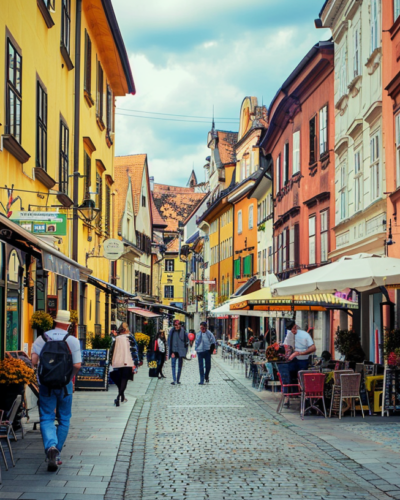Hasankeyf’s ancient beauty faces the rising tides of progress as the Ilisu Dam project looms. Here, we tell a story of heritage vs. development.
Nestled in the heart of Turkey, the ancient city of Hasankeyf, with its remarkable 12,000-year history, stands at a crossroads between past and progress. As the Ilisu Dam project has been completed, it threatens to submerge this cradle of civilization underwater, sparking widespread controversy.
This article delves into the complex narrative of Hasankeyf, exploring the cultural, environmental, and social ramifications of a project that pits the promise of modern development against the preservation of invaluable heritage.
The Ancient Turkish City on the Brink: Understanding Hasankeyf’s Heritage
Perched on the banks of the Tigris River in the southeastern Turkey, Hasankeyf is a testament to human history, encapsulating millennia of human settlement within its landscape. This ancient Turkish city, which could soon be submerged due to the Ilisu Dam project, offers an unparalleled glimpse into the past, with its rich tapestry of cultures, civilizations, and architectural marvels.
Hasankeyf’s heritage is as diverse as it is ancient, dating back over 12,000 years. It has been home to numerous civilizations, including the Romans, Byzantines, and Ottomans, each leaving an indelible mark on the city’s cultural and architectural fabric. The city is dotted with historical treasures, from medieval minarets and domed mosques to ancient cave dwellings carved into limestone cliffs, telling stories of human ingenuity and resilience.
One of the most iconic symbols of Hasankeyf is the ancient bridge that once spanned the Tigris, acting as a critical link on the Silk Road and facilitating the flow of ideas, goods, and cultures between East and West. Though only the remnants of this bridge stand today, they serve as a poignant reminder of the city’s historical significance and its role in the annals of human history.
Moreover, Hasankeyf is not just an archaeological gem; it is also a vibrant community with deep-rooted connections to the land and the past. The prospect of flooding threatens not only the physical remnants of this ancient city but also the intangible heritage, including local traditions and lifestyles passed down through generations.
As Hasankeyf stands on the brink of an irreversible transformation, it is crucial to understand and appreciate the magnitude of what could be lost. The city is a living museum, a bridge to our past, and a reminder of the enduring human spirit. Preserving Hasankeyf’s heritage is not just about saving stones and structures but about maintaining our link to a past that shapes our identity and understanding of human civilization.
In facing the future, the story of Hasankeyf is a call to balance progress with preservation, reminding us of the delicate interplay between nurturing our cultural heritage and fostering development. As the waters rise, so does the urgency to recognize and protect the invaluable legacy of Hasankeyf for future generations.
The Ilisu Dam Project: A Modern Development’s Historical Cost
The Ilisu Dam Project represents a significant infrastructure endeavor by Turkey, aiming to boost economic development through hydroelectric power generation and irrigation.
However, this modern advancement comes with a steep historical cost, as it necessitates flooding the ancient city of Hasankeyf, a site with over 12,000 years of human history. The project underscores a contentious dilemma facing many developing nations: the pursuit of contemporary progress at the expense of invaluable cultural and archaeological heritage.
While the dam promises to enhance the ancient Turkish city’s energy security and agricultural efficiency, it also leads to the displacement of thousands and the underwater submersion of a rich historical legacy. This complex scenario exemplifies the ongoing global debate over balancing development needs with the preservation of cultural identity and history.
Local and Global Reactions: The Opposition Against Submerging Hasankeyf
The opposition against submerging Hasankeyf has been a subject of local and global concern. Hasankeyf is at risk of being flooded due to the construction of the Ilisu Dam project on the Tigris River. This issue has sparked significant activism and debate beyond the ancient Turkish city, both within the nation and worldwide.
Locally, there has been a strong pushback against the submergence of Hasankeyf. Many residents and activists have protested the dam’s construction, citing the loss of cultural heritage, displacement of communities, and environmental damage as primary concerns. Efforts to raise awareness and preserve the town’s rich history have been ongoing, with local groups advocating for alternative solutions to meet the region’s energy and water needs.
The opposition to submerging Hasankeyf has also garnered attention on the global stage. International organizations, environmental groups, and heritage conservationists have expressed their support for preserving Hasankeyf. The potential loss of this historically significant site has prompted calls for the Turkish government to reconsider the dam project and explore alternative approaches that would mitigate the impact on the town and its surroundings.
As of today, the Ilisu Dam project has been completed, and its reservoir began to fill in July 2019. This has raised concerns about the impending submergence of Hasankeyf and the irreversible loss of its cultural heritage. Despite these developments, efforts to raise awareness about the issue and advocate for the preservation of Hasankeyf continue both locally and internationally.
The opposition against submerging Hasankeyf remains a prominent issue, with local and global stakeholders advocating for the preservation of this ancient town. While the dam construction has finished, the debate surrounding Hasankeyf reflects broader discussions about balancing development with heritage conservation and environmental protection.
From Settlement to Submersion: The Timeline of Hasankeyf’s Fate
Hasankeyf has a rich and extensive timeline that spans over 12,000 years. This ancient Turkish city is a settlement that has been continuously inhabited since the Neolithic era and evolved into an important trading hub on the Silk Road. However, the construction of the Ilisu Dam on the Tigris River has posed a significant threat to Hasankeyf’s existence, leading to a contentious debate about its submergence.
The town’s cultural significance is evident in its archaeological remains, including 5,500 caves, a 15th-century mausoleum, and an ancient citadel. Hasankeyf’s residents, with a heritage blending Arab, Kurdish, and Turkish descent, have lived among these historical treasures for centuries. The impending flooding has prompted concerns about the loss of this invaluable cultural heritage and the displacement of the town’s inhabitants.
The Ilisu Dam project is expected to create a 121-square-mile reservoir and displace up to 78,000 people, predominantly of Kurdish origin. The project has faced local and global opposition, with activists and heritage conservationists advocating for the preservation of Hasankeyf. Despite these efforts, the flooding of the town appears inevitable.
The timeline of Hasankeyf’s fate reflects a centuries-old settlement that has withstood the test of time, only to face submersion due to modern development projects. The town’s unique cultural heritage and archaeological significance have drawn attention from around the world, with many expressing dismay at the potential loss of this ancient site.
The residents of Hasankeyf are apprehensive about the looming evacuation deadline, and local authorities have announced the impending closure of all roads leading to the town. The debate surrounding Hasankeyf’s submergence continues to raise fundamental questions about balancing development with heritage conservation and the preservation of ancient settlements.
As we reflect on the narrative of Hasankeyf and the Ilisu Dam project, it’s clear that the intersection of heritage and modernity presents complex challenges. The story of Hasankeyf is a call to action for all of us to consider the value of our global heritage sites and the impact of development on these irreplaceable treasures. Engage with us in dialogue, support preservation efforts, and become a part of the movement toward balancing progress with protecting our cultural legacy. For more insights and to join the conversation, visit ThisCityKnows.com.









